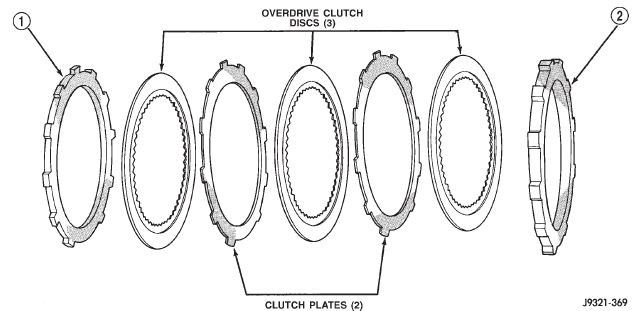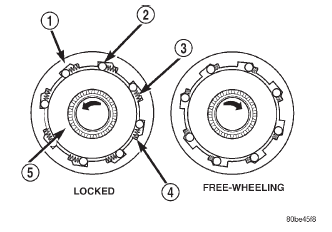Overdrive clutch. Overrunning clutch
DESCRIPTION The overdrive clutch (Fig. 56) is composed of the
pressure plate, two clutch plates, three holding discs,
overdrive piston retainer, piston, piston spacer, and
snap rings. The overdrive clutch is the forwardmost
component in the transmission overdrive unit and is
considered a holding component. The overdrive piston
retainer, piston, and piston spacer are located on
the rear of the main transmission case. NOTE: The number of discs and plates may vary
with each engine and vehicle combination. OPERATION To apply the clutch, pressure is applied between
the piston retainer and piston. The fluid pressure is
provided by the oil pump, transferred through the
control valves and passageways, and enters the
clutch through passages at the lower rear portion of
the valve body area. With pressure applied between
the piston retainer and piston, the piston moves
away from the piston retainer and compresses the
clutch pack. This action applies the clutch pack,
allowing torque to flow through the intermediate
shaft into the overdrive planetary gear set. The overdrive
clutch discs are attached to the overdrive clutch
hub while the overdrive clutch plates, reaction plate,
and pressure plate are lugged to the overdrive housing.
This allows the intermediate shaft to transfer
the engine torque to the planetary gear and overrunning
clutch. This drives the planetary gear inside the
annulus, which is attached to the overdrive clutch
drum and output shaft, creating the desired gear
ratio. The waved snap ring is used to cushion the
application of the clutch pack. DESCRIPTION The overrunning clutch (Fig. 57) consists of an
inner race, an outer race (or cam), rollers and
springs, and the spring retainer. The number of rollers
and springs depends on what transmission and
which overrunning clutch is being dealt with. OPERATION As the inner race is rotated in a clockwise direction
(as viewed from the front of the transmission), the
race causes the rollers to roll toward the springs,
causing them to compress against their retainer. The
compression of the springs increases the clearance
between the rollers and cam. This increased clearance
between the rollers and cam results in a freewheeling
condition. When the inner race attempts to rotate counterclockwise, the
action causes the rollers
to roll in the same direction as the race, aided by the
pushing of the springs. As the rollers try to move in
the same direction as the inner race, they are
wedged between the inner and outer races due to the
design of the cam. In this condition, the clutch is
locked and acts as one unit.
1 - REACTION PLATE 2 - PRESSURE PLATE
1 - OUTER RACE (CAM) 2 - ROLLER 3 - SPRING 4 - SPRING RETAINER 5 - INNER RACE (HUB)Overdrive clutch
Overrunning clutch
 Fig. 56 Overdrive Clutch
Fig. 56 Overdrive Clutch Fig. 57 Overrunning Clutch
Fig. 57 Overrunning Clutch
Dodge Durango (DN) 1998-2003 Service Manual
- Lubrication and Maintenance
- Suspension
- Differential and Driveline
- Brakes
- Cooling System
- Battery
- Starting Systems
- Charging System
- Ignition System
- Instrument Panel Systems
- Audio Systems
- Horn Systems
- Speed Control System
- Turn Signal and Hazard Warning Systems
- Wiper and Washer Systems
- Lamps
- Passive Restraint Systems
- Electrically Heated Systems
- Power Distribution System
- Power Lock Systems
- Vehicle Theft/Security Systems
- Power Seat System
- Power Window Systems
- Power Mirror Systems
- Chime/Buzzer Warning Systems
- Overhead Console Systems
- Engine
- Exhaust System
- Frame and Bumpers
- Fuel System
- Steering
- Transmission and Transfer Case
- Tires and Wheels
- Body
- Heating and Air Conditioning
- Emission Control Systems
- Introduction
